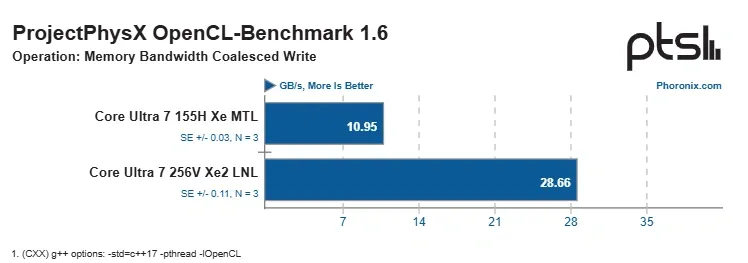Intel's Lunar Lake graphics has brought in a massive performance leap, particularly for GPU compute workloads.
The comparison of the latest ProjectPhysX OpenCL Benchmark between Lunar Lake and the previous Meteor Lake generation reveals significant improvements in various key metrics, such as FP64 performance, INT8 compute performance, and memory bandwidth.
FP64 Performance Boost
One of the most notable improvements in the Lunar Lake graphics is the huge uplift in FP64 (double precision floating-point) performance. The Xe2 Luna Lake graphics will outperform the meteor lake integrated graphics by a huge margin.
While Meteor Lake was already showing a significant increase over the previous iterations of Intel's integrated GPUs, Lunar Lake brings it to a higher level, making it a more comprehensive high-performance computing platform for scientific simulations and AI workloads requiring double precision.
INT8 Compute Performance
FP64 aside, Lunar Lake has an excellent INT8 compute performance. This drastic performance improvement over Meteor Lake settles Lunar Lake as a perfect candidate for workloads that use large amounts of operations based on integers, such as AI, machine learning, and data processing.
The latest open-source Intel graphics stack introduces the required performance of Lunar Lake to handle modern AI and data-centric workloads better.
Memory Bandwidth Optimizations
Memory bandwidth is another important improvement that is now enhanced with Lunar Lake thanks to the integrated memory approach of Intel on-package.
This new design enables quicker access to memory and, hence, better overall system performance, especially in memory-intensive applications like computational fluid dynamics and other GPU-heavy tasks.
This benefit extends beyond general compute tasks into a real-world difference in applications that require fast memory throughput.
FluidX3D: Real world benefits
While synthetic benchmarks such as ProjectPhysX OpenCL provide insight into raw performance, real-world workloads will give a clearer picture of how Lunar Lake performs under pressure.

A great example is FluidX3D, an OpenCL-accelerated CFD software package. Here, Lunar Lake really shines in this computational fluid dynamics test compared to the previous Meteor Lake generation, with an astonishing performance gain, indicating efficiency and power.
In testing, the Core Ultra 7 256V consumed a little more power than the Core Ultra 7 155H. Yet, despite the power difference, Lunar Lake's Core Ultra 7 256V not only matched the previous generation's performance but also offered a significant performance-per-Watt lead.

This means Lunar Lake can handle intensive tasks like CFD simulations with greater energy efficiency, making it a prime candidate for high-performance applications that require sustained computational power.
New age for Intel Integrated Graphics
The new Intel Integrated graphics Lunar Lake are a big leap forward for the company, which introduces unprecedented game-changing improvements in FP64, INT8, and memory bandwidth.
This is an opportunity that places Lunar Lake as the most suitable platform for demanding GPU compute workloads - AI and machine learning to CFD and other high-performance tasks.
With these significant performance boosts, Lunar Lake will likely become a key player in integrated graphics, offering users the power for general and specialized workloads.
Whether you're talking about large-scale AI models or fluid dynamics simulations, Lunar Lake provides the computational power, efficiency, and scalability necessary for modern, data-driven applications. Intel has clearly pushed the envelope, marking a new chapter in integrated graphics performance.







